Abstract
Nitric oxide synthase-containing cells were visualized in the anterior pituitary gland by immunocytochemistry. Consequently, we began an evaluation of the possible role of NO in the control of anterior pituitary function. Prolactin is normally under inhibitory hypothalamic control, and in vitro the gland secretes large quantities of the hormone. When hemipituitaries were incubated for 30 min in the presence of sodium nitroprusside, a releaser of NO, prolactin release was inhibited. This suppression was completely blocked by the scavenger of NO, hemoglobin. Analogs of arginine, such as NG-monomethyl-L-arginine (NMMA, where NG is the terminal guanidino nitrogen) and nitroarginine methyl ester, inhibit NO synthase. Incubation of hemipituitaries with either of these compounds significantly increased prolactin release. Since in other tissues most of the actions of NO are mediated by activation of soluble guanylate cyclase with the formation of cyclic GMP, we evaluated the effects of cyclic GMP on prolactin release. Cyclic GMP (10 mM) produced an approximately 40% reduction in prolactin release. Prolactin release in vivo and in vitro can be stimulated by several peptides, which include vasoactive intestinal polypeptide and substance P. Consequently, we evaluated the possible role of NO in these stimulations by incubating the glands in the presence of either of these peptides alone or in combination with NMMA. In the case of vasoactive intestinal polypeptide, the significant stimulation of prolactin release was augmented by NMMA to give an additive effect. In the case of substance P, there was a smaller but significant release of prolactin that was not significantly augmented by NMMA. We conclude that NO has little effect on the stimulatory action of these two peptides on prolactin release. Dopamine (0.1 microM), an inhibitor of prolactin release, reduced prolactin release, and this inhibitory action was significantly blocked by either hemoglobin (20 micrograms/ml) or NMMA and was completely blocked by 1 mM nitroarginine methyl ester. Atrial natriuretic factor at 1 microM also reduced prolactin release, and its action was completely blocked by NMMA. In contrast to these results with prolactin, luteinizing hormone (LH) was measured in the same medium in which the effect of nitroprusside was tested on prolactin release, there was no effect of nitroprusside, hemoglobin, or the combination of nitroprusside and hemoglobin on luteinizing hormone release. Therefore, in contrast to its inhibitory action on prolactin release NO had no effect on luteinizing hormone release. Immunocytochemical studies by others have shown that NO synthase is present in the folliculostellate cells and also the gonadotrophs of the pituitary gland. We conclude that NO produced by either of these cell types may diffuse to the lactotropes, where it can inhibit prolactin release. NO appears to play little role in the prolactin-releasing action of vasoactive intestinal polypeptide and substance P, but mediates the prolactin-inhibiting activity of dopamine and atrial natriuretic factor.
Full text
PDF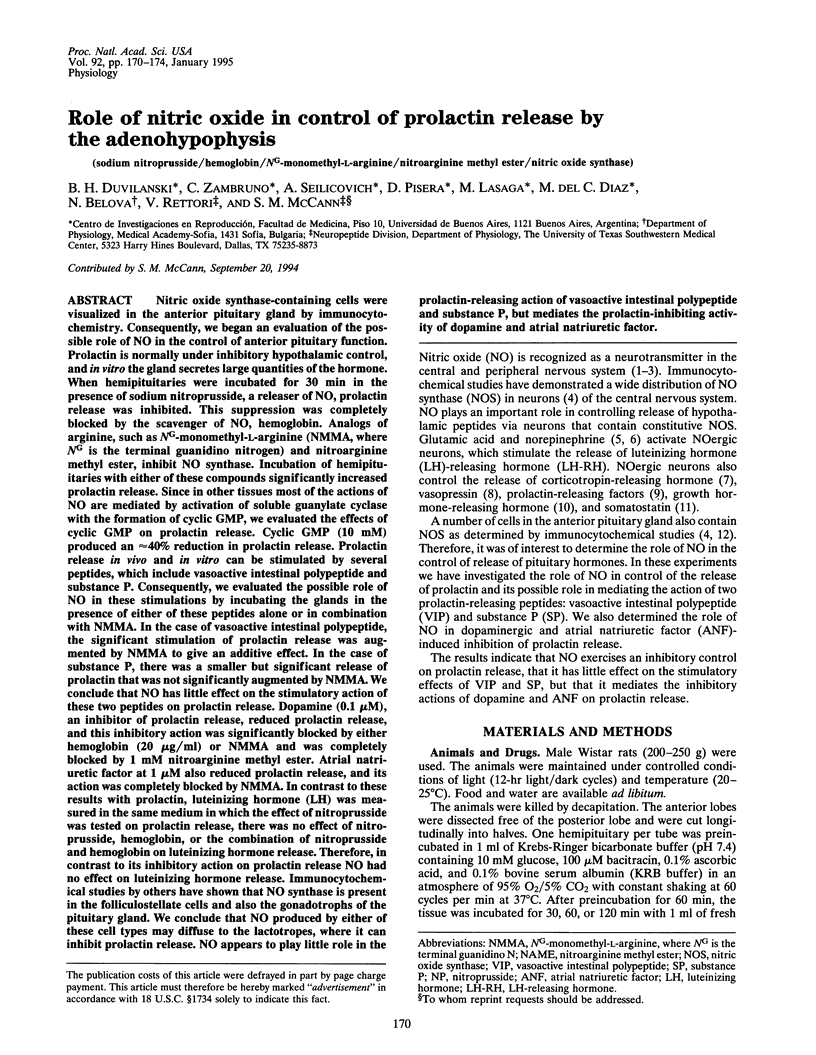
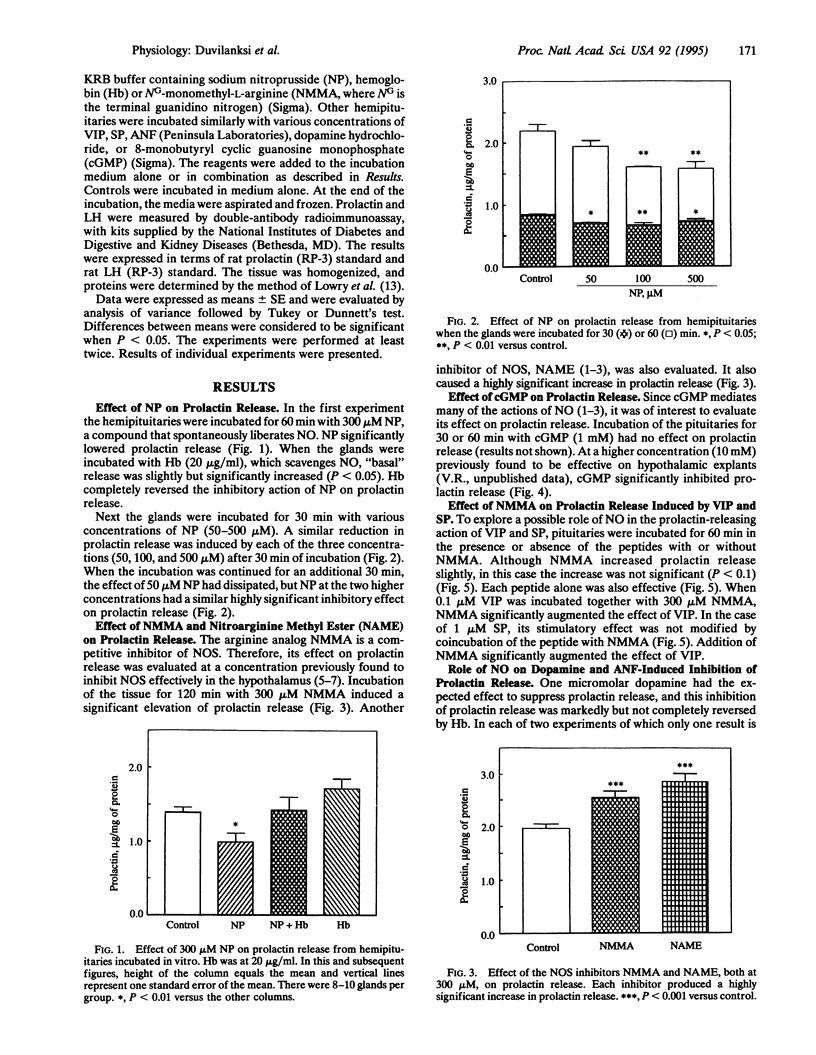
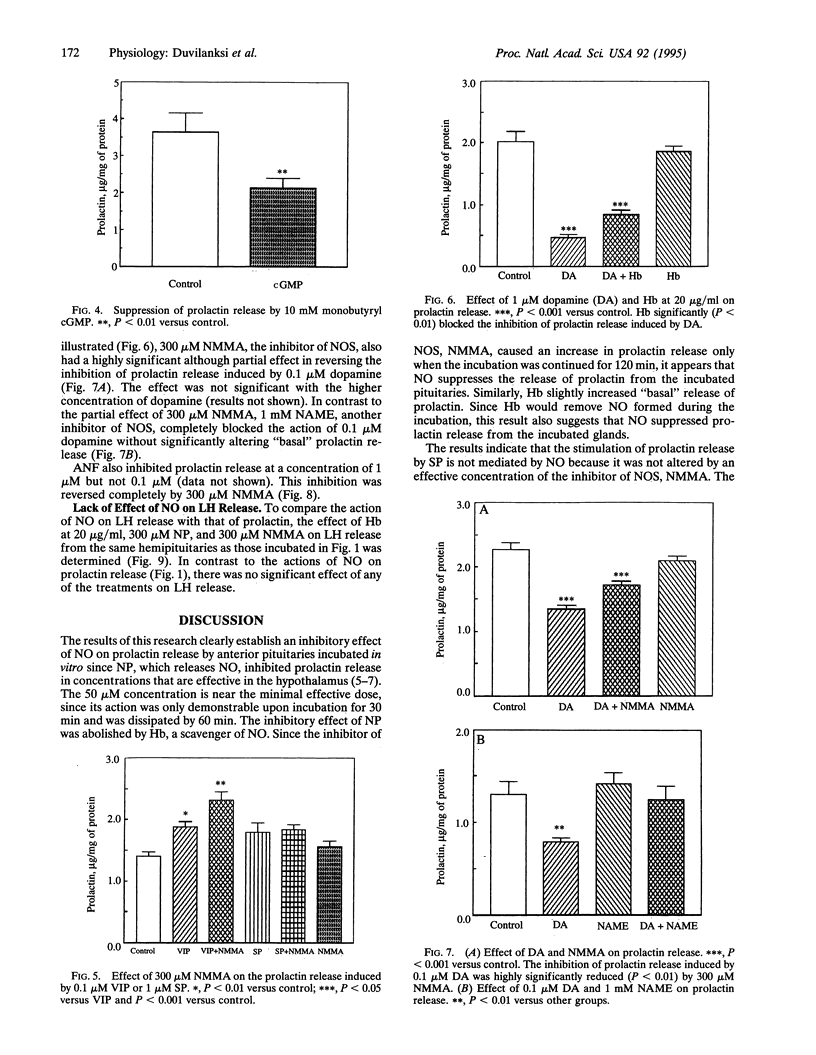
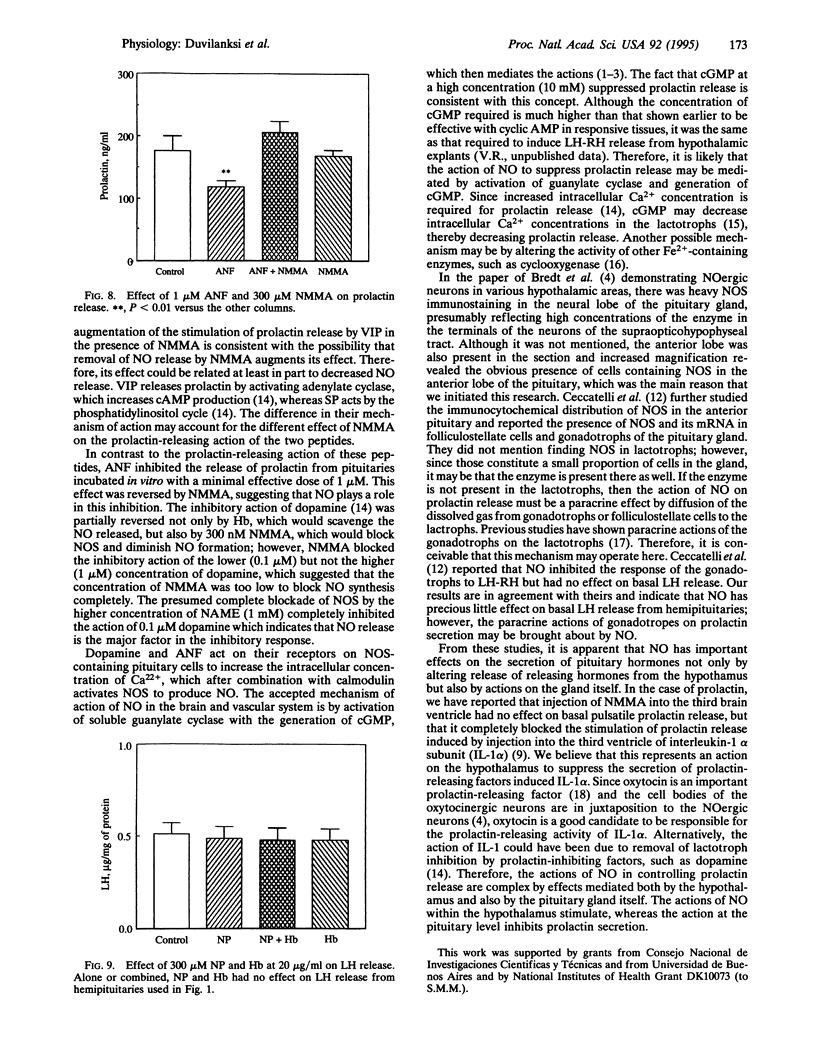
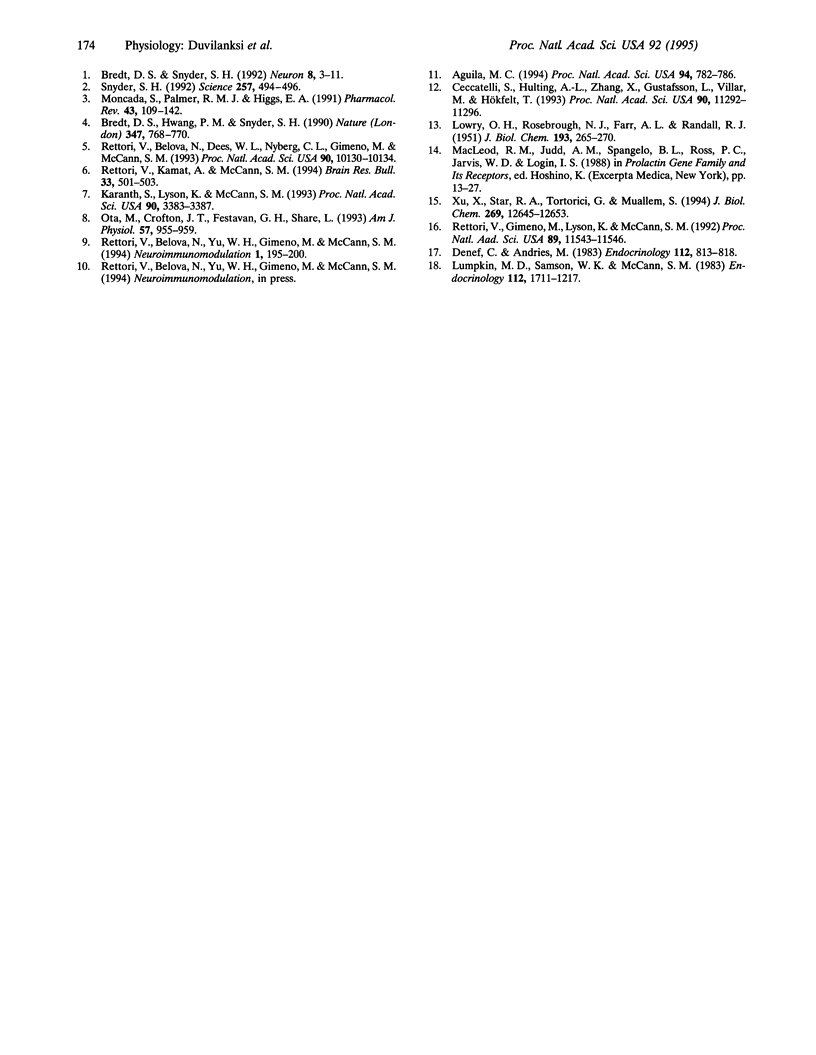
Selected References
These references are in PubMed. This may not be the complete list of references from this article.
- Aguila M. C. Growth hormone-releasing factor increases somatostatin release and mRNA levels in the rat periventricular nucleus via nitric oxide by activation of guanylate cyclase. Proc Natl Acad Sci U S A. 1994 Jan 18;91(2):782–786. doi: 10.1073/pnas.91.2.782. [DOI] [PMC free article] [PubMed] [Google Scholar]
- Bredt D. S., Hwang P. M., Snyder S. H. Localization of nitric oxide synthase indicating a neural role for nitric oxide. Nature. 1990 Oct 25;347(6295):768–770. doi: 10.1038/347768a0. [DOI] [PubMed] [Google Scholar]
- Bredt D. S., Snyder S. H. Nitric oxide, a novel neuronal messenger. Neuron. 1992 Jan;8(1):3–11. doi: 10.1016/0896-6273(92)90104-l. [DOI] [PubMed] [Google Scholar]
- Ceccatelli S., Hulting A. L., Zhang X., Gustafsson L., Villar M., Hökfelt T. Nitric oxide synthase in the rat anterior pituitary gland and the role of nitric oxide in regulation of luteinizing hormone secretion. Proc Natl Acad Sci U S A. 1993 Dec 1;90(23):11292–11296. doi: 10.1073/pnas.90.23.11292. [DOI] [PMC free article] [PubMed] [Google Scholar]
- Denef C., Andries M. Evidence for paracrine interaction between gonadotrophs and lactotrophs in pituitary cell aggregates. Endocrinology. 1983 Mar;112(3):813–822. doi: 10.1210/endo-112-3-813. [DOI] [PubMed] [Google Scholar]
- Karanth S., Lyson K., McCann S. M. Role of nitric oxide in interleukin 2-induced corticotropin-releasing factor release from incubated hypothalami. Proc Natl Acad Sci U S A. 1993 Apr 15;90(8):3383–3387. doi: 10.1073/pnas.90.8.3383. [DOI] [PMC free article] [PubMed] [Google Scholar]
- LOWRY O. H., ROSEBROUGH N. J., FARR A. L., RANDALL R. J. Protein measurement with the Folin phenol reagent. J Biol Chem. 1951 Nov;193(1):265–275. [PubMed] [Google Scholar]
- Lumpkin M. D., Samson W. K., McCann S. M. Hypothalamic and pituitary sites of action of oxytocin to alter prolactin secretion in the rat. Endocrinology. 1983 May;112(5):1711–1717. doi: 10.1210/endo-112-5-1711. [DOI] [PubMed] [Google Scholar]
- Moncada S., Palmer R. M., Higgs E. A. Nitric oxide: physiology, pathophysiology, and pharmacology. Pharmacol Rev. 1991 Jun;43(2):109–142. [PubMed] [Google Scholar]
- Ota M., Crofton J. T., Festavan G. T., Share L. Evidence that nitric oxide can act centrally to stimulate vasopressin release. Neuroendocrinology. 1993 May;57(5):955–959. doi: 10.1159/000126459. [DOI] [PubMed] [Google Scholar]
- Rettori V., Belova N., Dees W. L., Nyberg C. L., Gimeno M., McCann S. M. Role of nitric oxide in the control of luteinizing hormone-releasing hormone release in vivo and in vitro. Proc Natl Acad Sci U S A. 1993 Nov 1;90(21):10130–10134. doi: 10.1073/pnas.90.21.10130. [DOI] [PMC free article] [PubMed] [Google Scholar]
- Rettori V., Belova N., Yu W. H., Gimeno M., McCann S. M. Role of nitric oxide in control of growth hormone release in the rat. Neuroimmunomodulation. 1994 May-Jun;1(3):195–200. doi: 10.1159/000097160. [DOI] [PubMed] [Google Scholar]
- Rettori V., Gimeno M., Lyson K., McCann S. M. Nitric oxide mediates norepinephrine-induced prostaglandin E2 release from the hypothalamus. Proc Natl Acad Sci U S A. 1992 Dec 1;89(23):11543–11546. doi: 10.1073/pnas.89.23.11543. [DOI] [PMC free article] [PubMed] [Google Scholar]
- Rettori V., Kamat A., McCann S. M. Nitric oxide mediates the stimulation of luteinizing-hormone releasing hormone release induced by glutamic acid in vitro. Brain Res Bull. 1994;33(5):501–503. doi: 10.1016/0361-9230(94)90074-4. [DOI] [PubMed] [Google Scholar]
- Snyder S. H. Nitric oxide: first in a new class of neurotransmitters. Science. 1992 Jul 24;257(5069):494–496. doi: 10.1126/science.1353273. [DOI] [PubMed] [Google Scholar]
- Xu X., Star R. A., Tortorici G., Muallem S. Depletion of intracellular Ca2+ stores activates nitric-oxide synthase to generate cGMP and regulate Ca2+ influx. J Biol Chem. 1994 Apr 29;269(17):12645–12653. [PubMed] [Google Scholar]


